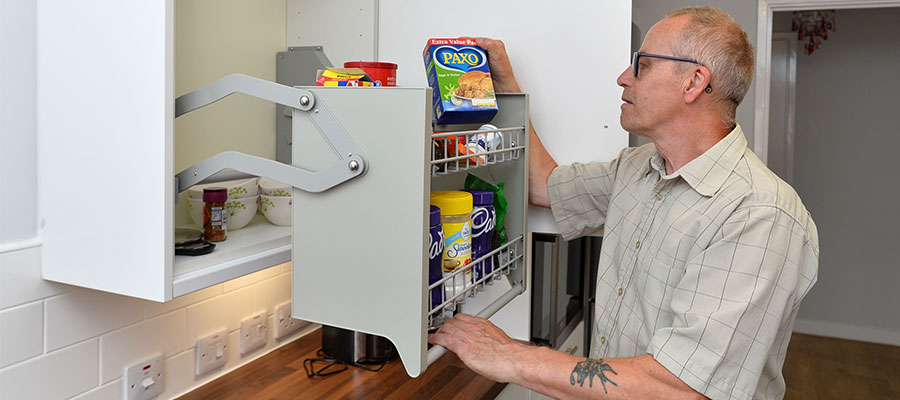Victoria Galligan spoke to Habinteg housing association’s Chief Executive Sheron Carter about the history of accessible housing in the UK, the latest standards in housebuilding and how more needs to be done to future-proof homes so they can be used for life…
Habinteg is a housing association with a difference – its properties are all built using an accessible design model which means people with disabilities can get around easily, and residents are housed within mixed housing so they are not isolated from the rest of society but integrated within it.
Sheron explains: “Habinteg was set up in 1970 and it has an interesting history. Back then, if a person had a disability they would likely live in a care facility.”
Leading figures from the world of disability were interested in alternative forms of accommodation for people with disabilities.
Sheron adds: “They visited Sweden to look at integrated housing – a model called Fokus had been developed there and it was very forward-thinking, with a cluster of around 15 houses or apartments, of which some had been built specifically for disabled people.”

This type of independent housing, situated among communities rather than separate to them, was revolutionary at the time but now seems like simple common sense – why would someone with a disability want to live outside the community and be marginalised from their friends and family?
Sheron added: “When the disability campaigners came back they approached Scope [which back then was the Spastics Society] and said: ‘We need to do something to change things here for disabled people’. This is how Habinteg was born – the word is a combination of the Latin habitus integrans, or ‘integrated housing’.”
The first innovative scheme was developed in Tottenham and Habinteg’s aim since then has been to go wherever it is needed most – the housing association now offers over 3,300 homes nationwide and works with 86 local authorities.
Building accessible homes as standard
The aims of Habinteg are two-fold: to not only build and manage accessible homes but to encourage the housebuilding industry to create homes which meet accessibility standards from the off – even if the intended residents are not disabled.
More homes are needed – but one housing association alone cannot offer the number of accessible homes which the UK should ideally have to offer. However, by working together with Government, housebuilders and disability organisations the hope at Habinteg is that the standards of accessible housing will be adopted on a wider scale. This will help people to stay in their own homes longer, should they become unexpectedly disabled or as they age and become less mobile.
Sheron says: “Our organisation can show how it is possible to design, build and manage accessible and adaptable buildings. But we also promote integration and integrated housing among other organisations. Our homes are in England and Wales – from Middlesborough in the North, to Wales, Cornwall, the Midlands and all along the South-West Corridor.”
The model on which Habinteg homes were built in the 70s has changed over the years but the ethos remains the same – to create integrated, accessible and adaptable housing which will meet the needs of everyone in society.
And the building standards of accessible housing have also changed – Sheron outlined the two different types: “There is the acceptable accessible building standard (Category 2) which has already been adopted in London – meaning all new homes in the capital are now built to this standard. Then there is the wheelchair standard (Category 3). We are working with the Ministry of Housing, Local Government Association, local authorities and other organisations to try and ensure that Category 2 becomes a mandatory standard for all new homes.”
The future of accessible housing
Habinteg’s research on housing, “A forecast for accessible homes”, predicts that less than a quarter of homes built outside London by 2030 will be suitable for older and disabled people.
That means that those looking for an accessible home will be tied to certain areas – resulting in people with disabilities becoming “trapped”. This does not only mean trapped in the literal sense of not being able to get in and out of a home which is not suitable for disabled living, but also trapped once a resident has found an accessible home.
Sheron says: “People experience real joy when they are allocated an accessible home. But further down the line, if they ever want to move, it’s so difficult to find an alternative in a different part of the country that they become trapped in that accessible home.”
The need for more accessible and adaptable homes is clear – they are not currently readily available. With an ageing population, the need for people to stay in their own homes for longer and be able to live near their place of work or their family means the UK is heading for an accessible housing crisis. It is not acceptable for families to be placed on seemingly endless waiting lists until a suitable property becomes available.
Habinteg is clearly pushing the Government in the right direction to create accessible homes – but only making Category 2 a mandatory standard will increase the number of properties available to older and disabled residents.
The answer could lie in high-rise, modular-built homes – although Sheron highlights the fact that Grenfell brought home the need for vulnerable people to have a safe exit. Habinteg advocates that wheelchair users and those with mobility issues should live on lower floors, while work is being done by the fire service to ensure that fires are contained to one part of the building – enabling this type of dense housing to become safer to live in.
With more accessible homes on the horizon and organisations such as Habinteg fighting the corner for disabled people, let’s hope everyone can soon have access to suitable housing –without the waiting lists.
- Log in to post comments













